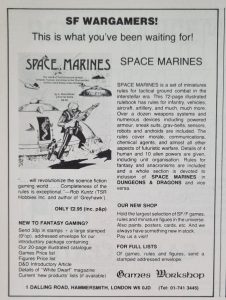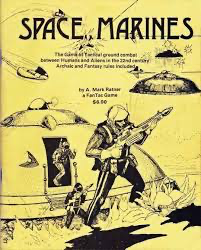Space Marine
by A. Mark Ratner
FGU edition Cover by Jeff Dee, interior art by David Sutherland
Introduction
We know where the image of star-travelling troops aboard naval vessels, clad in armour comes from, the Valerian Marines in the “Lensman” Series and the CAP Drop Troopers of “Starship Troopers”. The Lensman troopers are strong enough not to need power assist, but the series does have examples of powered armour.
 Then, in 1978, Games Workshop let gamers in the UK know about a new ser of SF war games rules, called “Space Marine”!. That’s right, for the low, low price of £2.95 including postage, they were selling A. Mark Ratner’s rules as published by Fantac (later also in 1980 by Fantasy Games Unlimited)! That is about £16 in Sept 2023 money.
Then, in 1978, Games Workshop let gamers in the UK know about a new ser of SF war games rules, called “Space Marine”!. That’s right, for the low, low price of £2.95 including postage, they were selling A. Mark Ratner’s rules as published by Fantac (later also in 1980 by Fantasy Games Unlimited)! That is about £16 in Sept 2023 money.
You can tell these are early rules, as well as normal six-sided dice, there are occasions to use a d20 or d20s as percentile dice, but accepts that getting these might be hard, and gives the advice on picking numbered chits from a cup, as we did in those primitive days.
Intended as a game of Squad/Section combat. It offers two ground scales of combat, depending on how much table space you have, but also a skirmish scale, only back them skirmish meant two or three figures a side, the full Squad based battle is envisaged as only being between ten and twenty figures a side.
There is a background for the universe. In the future of interstellar travel, the warring nations have developed a field that prevents nuclear detonations, rendering nuclear bombardment impossible, so interstellar war once again needs boots on the ground to achieve political objectives.
The Fantac edition was, to my knowledge, was self-published by A. Mark Ratner, who I did briefly communicate with back around 2000, however I only have the FGU edition, not the original Fantac edition, and one big difference that I understand the original has that the later does not is that it has rules for linking the wargame with D&D and Metamorphosis Alpha.
What are the rules like?
The game covers attacks on a planet from Orbital Bombardment, Air combat to Ground actions, but only really ground combat has extensive rules. Fire from Orbit is treated as indirect fire to the ground, but anti-ship fire from the ground is left up to a referee.
Aircraft can be used for troop transport, recon of ground troops, air superiority or ground attack, but the author realises that the scale of action is too small for proper air to air combat, so air superiority is abstracted.
On the ground, it is assumed that troops will be using the benefit of train cover and stealth technology to not be seen, so recon aircraft, and troops trying to find their opponents, is part of the game.
The game can use simultaneous movement, with written orders, but the basic turn sequence is
- Roll for first/second move
- First side move
- Second side move
- Both sides cab perform covering fire, that is over watch fire on moving units. Non moving units can attempt to spot enemies.
- Units can try to spot units and conduct normal fire
- Indirect fire occurs
- Melee combat
- Back to 1
I have seen “Space Marine” referred to as the “Chainmail” of “Space Opera”, referring to Howe the original D&D was both developed from the “Chainmail” war games rules and still needed the original war games rules to make sense of the combat in the RPG. If you played Space Opera, the combat rules do look like a more constrained version of the Space Opera combat rules.
Hit chances are made using percentile dice (and the intro explains how that is done) with situational modifiers. Once you hit,you consult another tangle to cross-reference weapon vs armour to determine the chance of the hit penetrating defences. This is probably survivable when you have a max of two squads each on the table, but would be atrocious for Company sized actions, and you equate a hit with putting a figure out of action.
There are more detailed wound rules, but these look more designed for the skirmish game, as it would mean a lot of book keeping for the regular game.
There are a lot more to the rules,movement, unit cohesion (the faster you can move, the further apart you are allowed to be), electronic warfare, pinning and suppression, different types of weapons, robots vehicles for the various Star Nations and armour. If you have Space Opera and the Ground and Air Equipment book, a lot of this is going to be very familiar.
Build me an army worthy of the Terran Federation
The points system for armies is a little strange as it is not intended for buying your units in a single battle. In fact the text says that the only reason their is one is because Scott Bizar insisted on one.
Despite the fact that this is set up for small unit action, you buy army regiments and wings of aircraft and all equipment. You need to use the description of the army organisation of what a regiment looks like to see what that buys you, and you will send your troops out in their squads for actual games.
There is no balancing for troop experience and, despite the claims of the purchasing of regiments being for campaigns, there are no campaign rules. The impression I get is that the author wanted rules for more free form, possibly asymmetrical actions, in games created by art and judgement, not mechanically defined ideas of fairness.
E.g. You want to field a force of a couple of Ranan infantry squads, twenty Ranai, with a Supporting Flame Crawler, trying to use the points cost for all that. Breaking down the over 1000 troops and 100 AFV
Presentation
The book is a very simple, two column format, the text is a little small for me now, but was fine at the time. The only differentiation in typeface are use of bold for item heads, and headings in a large font that I suspect might be intended to be neon tubes.
The tables are that FGU way of just headings with values in the columns. No lines, banding or aids to help you cross reference column as row.
The art is sparse, but exists only to break up text. There are absolutely no illustrative diagram to help explain the rules.
The rules need editing, reorganising and indexing. There are also areas that could use expanding. Even if there were not firm rules on army composition then at least there should be more info in running campaigns
Background and theme
 The nations of this background formed the basis of the background in Ed Simbalist’s Space Opera SF RPG, I believe at the insistence of FGU’s owner Scott Bizar. I do not believe that this was by the choice of either author.
The nations of this background formed the basis of the background in Ed Simbalist’s Space Opera SF RPG, I believe at the insistence of FGU’s owner Scott Bizar. I do not believe that this was by the choice of either author.
This background is where the fascist Azuriachs, ursine Blarads and communist Galactic Peoples Republic of Space Opera come from, with varying levels of detail. As memory serves, only the Terran Union, Azuriachs and the Mercantile League get any extensive Star Atlas coverage, with minor mentions for the Raan, Blarads and Mekpurrs. The Korellians who feature in a Star Atlas are not in Space Marine,
Space Opera alluded to the various Star Nations, but did not give much detail. In Space Marine, the basics of each are given, making it handy for any Space Opera GM.
The background details are more concerned with uniform details, symbology tactical organisation and equipment used by the various Star Nations, but gives the basic notion of their governmental character.
Would I play these rules now?
At the time, I can see why people would have liked these. Judging by the standards of the time they were written, compared to other rules of the time I have read, they compare well.
Since then, expectations have changed. In some ways that is worse, popular rules tend to be more rigid and less free-form. I did consider breaking out some SF minis and pit a few squaddies against each other, but after reading decided not to. Too much table cross referencing and page flipping, though i guess I could have made unit cards with just the details for simplicity’s sake.
If I was still running Space Opera, I might splice these rules into it if there was a need for the characters to get involved in small unit combat, much as Traveller could do with Striker.
That is not to say that there are not fun ideas in here. Once you accept that the view of combat is dated. Aircraft fly nap of earth with no fear of RADAR that can reach the crowns, MANPADS or vehicles flinging vapourising volumes of lead into the air. It is an old view of the future, no drones. IEDs or mobile phones with cameras and geo-location, though there are some things that could be charitably considered to be IFVs.
Why the Terran Union has a Continental Siege Unit listed, basically a Bolo or Ogre in a small squad game, i dunno, but it is a sign of a game that could have used a bit more work developing it.
All that being said, if you wanted to use that 60s and 70s view of future warfare, but want to use your own simpler and more consistent system, the ideas here are worth stealing for a universe with a feel of the one of the Dorsai or the poor infantry not cool enough to support Hammers Slammers.
You can still buy the FGU edition rules in PDF form from DriveThruRPG

